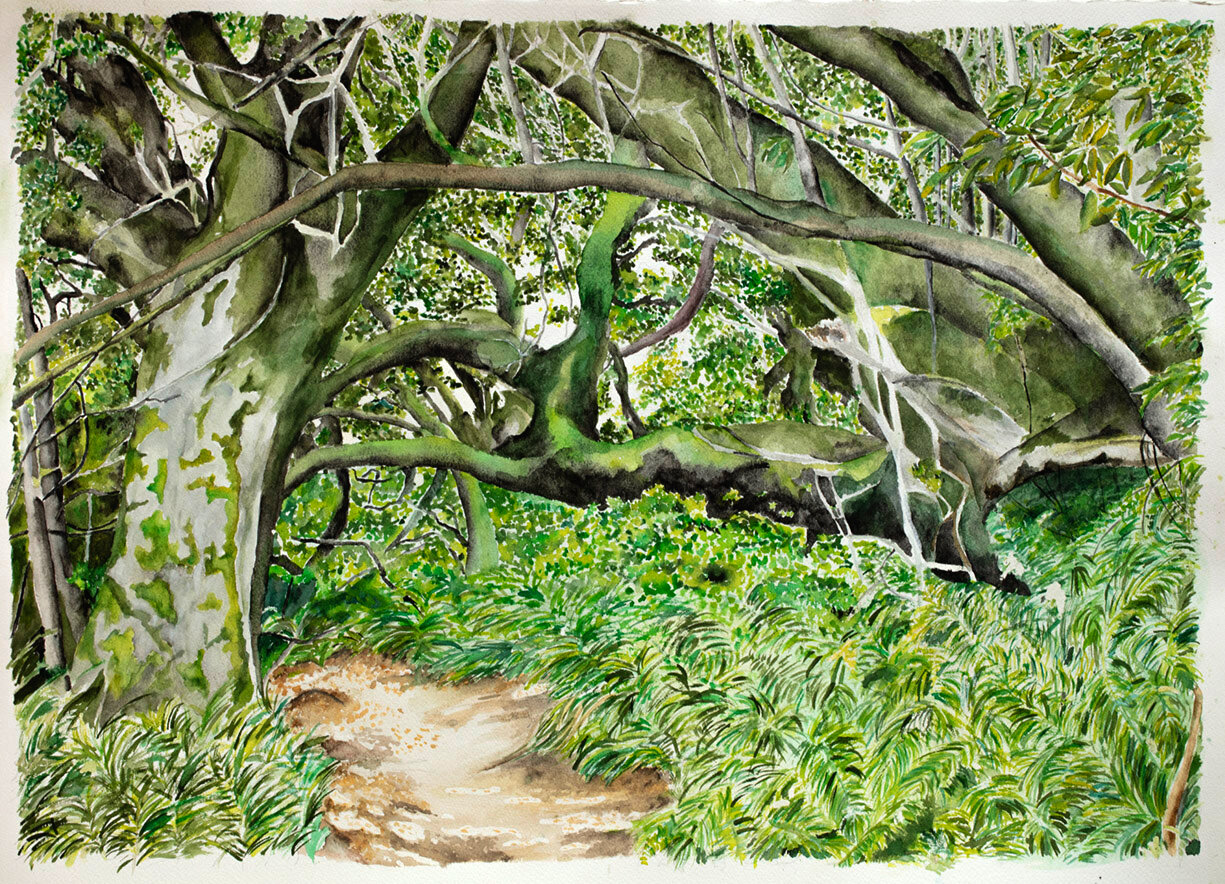Fire Cloud from our house on Inverness Ridge
Point Reyes is burning with the Woodward fire. It came within two miles of our studio. From the top of the Inverness Ridge we watched the dry lightning storm in amazement - we could see bolts repeatedly striking the sea. Their flashes and thunder were a grand spectacle. The lighting came ashore and blasted Inverness Ridge to our south. The lightning started two fires in Point Reyes National Seashore. They were in a deep canyon north of the junction of the Coast Camp Trail and the Woodward Valley Trail. These fires ultimately joined together. Unfortunately because of other fires that started during the storm, no airplanes were available to bomb the flames for three days. With gusty winds, the fire grew. It was frightening to watch from our house. There was an ever increasing smoke cloud. At night we could see an orange glow from the flames. We started the impossible task of packing our cars with forty years of art; paintings, prints, Richard’s black and white negatives, passports, hard drives, and some clothes.
Cows, fire cloud and the estero
For days, it seemed that there was no containment. Fortunately, more help became available. Two airplanes carrying 16,000 gallons water each, buzzed our house many times before dropping their loads on to the fire.
Plane flying above our house - Kathleen P. Goodwin
The number of people working on the fire grew to 568, 13 fire crews, 37 engines, four helicopters, five bulldozers, five water tenders and one masticator. The latter is a large piece of machinery which reduces the size of forest vegetation and downed material by grinding/shredding, chunking and chopping on site. Heavy fog arrived. It really helped fireman although it severely limited the use of the airplanes. There was quite a bit of smoke, some of it caused by backfires that the crews set to increase the width of firebreaks made by bulldozers. At the present, containment is at 97% and it covers nearly 5000 acres.
We are now confident our house will survive this fire. It does continue to burn and will be fully out once the heavy rains start.
We have decided we need an alternative place to store our artwork. We are looking for solutions for this. Any suggestions would be helpful. One idea Richard has is to get a cargo van which we would fill up with artwork, either driving off during an emergency or leave it in a safe place, like a friend’s home during fire season.
It is helpful to be an artist in trying times like these. Art takes your mind off troubles - you can concentrate on the task at hand.
I have been working on a very detailed watercolor of a view of the path down to Pebble Beach in Tomales Bay State Park which I had photographed in June. The watercolor is 22” x 30”. I started it on August 1 by projecting the image on to the thick watercolor paper. I did a rough outline to make the proportions accurate. I protected areas that I knew I wanted to keep white with masking fluid. It has taken weeks but now I believe it is finished though I am still looking at it periodically to see if there is anything else I need to do.
Meanwhile Richard has been photographing digitally thousands of slides and large format film he has taken over his 55 years of being a photographer. He has an ingenious method of photographing the film with his digital camera and saving the digital files immediately to his computer.
He is working with Nadia Negm, a young Egyptian woman who recently graduated from UC Berkeley with a degree in film and media. She is an Olympic rower having represented Egypt in 2016. She applies the same degree of focus, intelligence and energy she needed to become an Olympic athlete to her position as assistant. Richard says it is quite a challenge to keep up with up with her. He is going through his slides, choosing the ones he want to digitize, making a stack for Nadia. She puts each one individually under the camera using the light table for focus and alignment. Then the exposure is made with a powerful studio flash.
Nadia wants to be an environmental photographer so really is an ideal fit for us and her. She is learning much from Richard and she is really helping us out. We are employing her through our non-profit organization, Environmental Eye. We will be making these photographs available to approved non-profit environmental groups who use the images on line and in brochures and publications.
For those of you who are interested in the technique, here it is:
Here is an example of a slide photographed in the early 70s:




